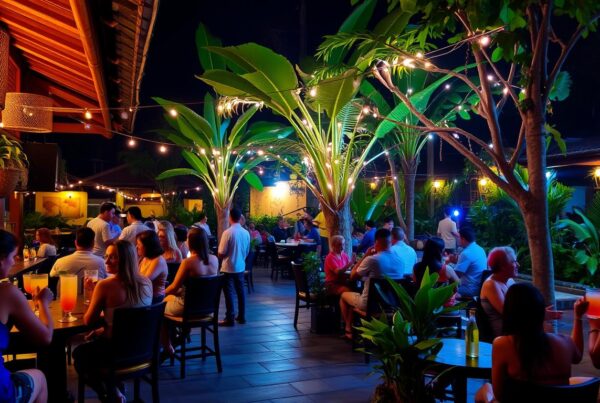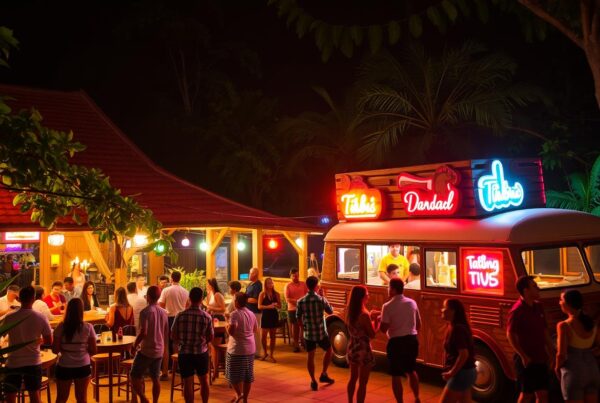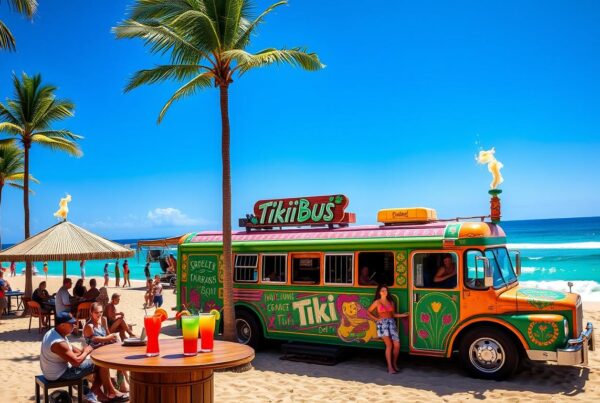Mixology has a rich history spanning thousands of years. Ancient concoctions to modern-day marvels have shaped cocktail culture. Let’s explore the origins and development of these beloved spirits.
Cocktail history traces back to ancient civilisations. Minoan Cretans blended proto-cocktails 3,000 years ago. Greeks experimented with flavouring wine using honey and seawater.
The term “cocktail” was first defined in 1806. This milestone appeared in The Balance and Columbian Repository of Hudson, New York. It set the stage for future creative explosions.
The 19th century introduced influential figures in spirits. Jerry Thomas, known as the “Professor,” wrote The Bartender’s Guide. This book inspired generations of bartenders to come.
Key Takeaways
- Cocktail culture has roots dating back thousands of years
- The term “cocktail” was officially defined in 1806
- Jerry Thomas’s The Bartender’s Guide was a pivotal publication
- Ice availability revolutionised cocktail making in the 1800s
- Prohibition and world events significantly impacted cocktail trends
- The 1990s saw a renaissance in classic cocktail culture
The Origins of Mixed Drinks
Mixed drinks have a rich history spanning thousands of years. Ancient civilisations experimented with blending different beverages. These early concoctions laid the foundation for modern cocktail recipes.
Ancient Concoctions: From China to Greece
Ancient drinks were complex and varied. Minoan Cretans mixed beer, mead, and wine 3000 years ago. Chinese rice wine featured herbs and fruits.
Greeks added spices to their wine. This created intricate flavour profiles that still influence mixology today.
Medieval Mixology: Spices and Sugar Enter the Scene
In medieval times, mixing drinks became an art form. Wealthy people flavoured ales and meads with exotic spices and sugars. This era saw the birth of punch in India.
Punch blended spirit, sugar, spices, water, and citrus fruit. It emerged nearly 1500 years ago, shaping future cocktail recipes.
The Arrival of Distillation: New Possibilities Emerge
Arab traders brought distillation techniques to Europe. Monks refined these methods, leading to new liqueur creations. By Shakespeare’s time, mixed drinks like ‘sugar sack’ gained popularity.
Sack-possets also became fashionable during this period. These early experiments paved the way for today’s diverse cocktail range.
| Era | Drink Innovation | Key Ingredient |
|---|---|---|
| Ancient Times | Proto-cocktail | Beer, mead, wine |
| Medieval Period | Punch | Spirit, sugar, spices |
| Renaissance | Sugar sack | Sweetened sherry |
Early mixology developments shaped modern bartending techniques. They continue to inspire new recipes. Today’s diverse cocktail world owes much to these historical innovations.
The Birth of Punch: India’s Contribution to Cocktail Culture
Punch, the world’s oldest cocktail, originated in India. This classic drink has a 1500-year heritage. It usually had five key ingredients: arak, sugar, water, citrus juice, and spices.
In the 17th century, punch travelled to Europe with colonisers. The drink quickly gained popularity and adapted to local tastes. In the British West Indies, rum replaced arak, creating the rum punches we know today.
Punch recipes could be served hot or cold, suiting different seasons. This flexibility helped it remain popular in cocktail culture for centuries.
“Punch is the lifeblood of social gatherings, a drink that brings people together and tells a story of cultural exchange.”
Indian cocktails keep evolving, with bartenders adding modern twists to classics. Local gin distilleries use regional botanicals, reviving drinks like the Gin & Tonic. This trend shows India’s cocktail scene honouring its past while embracing new ideas.
| Traditional Punch Ingredients | Modern Indian Twists |
|---|---|
| Arak or Rum | Local Gins (e.g., Tamras, Kumaon & I) |
| Sugar | Infused Syrups |
| Citrus Juice | Exotic Fruit Juices |
| Spices | Native Indian Spices and Herbs |
| Water | Flavoured Tonics |
American Taverns: The Cradle of Cocktail Creativity
Colonial American taverns were hubs of mixology innovation. These lively spots nurtured a thriving culture of unique drinks. They set the stage for the American cocktails we enjoy today.
Popular 18th Century Drinks: Flips, Slings, and Toddies
Colonial mixology birthed a variety of beloved concoctions. Flips warmed patrons with a hearty blend of beer, sugar, rum, eggs, and spices.
Slings offered a simpler pleasure, mixing spirits with sugar and water. Toddies soothed sore throats with sweetened, heated spirits and a dash of spice.
The Rise of the Mint Julep
The Southern United States introduced the world to the mint julep. It began as a mint-flavoured whisky breakfast drink. The julep quickly evolved into a classic American cocktail, becoming popular across the region.
Saloon Specialties: Quirky Names and Local Favourites
By the 1820s, saloons began featuring unique in-house specialities. These tavern drinks often had quirky names reflecting local tastes and ingredients.
This trend of creative naming and local flavours continues in modern American cocktail culture.
| Drink | Main Ingredients | Origin |
|---|---|---|
| Flip | Beer, sugar, rum, eggs, spices | Colonial America |
| Sling | Spirit, sugar, water | 18th century taverns |
| Toddy | Sweetened heated spirits, spices | Colonial America |
| Mint Julep | Whisky, mint, sugar | Southern United States |
These early American cocktails continue to inspire modern mixology. Bartenders still draw inspiration from these colonial classics, keeping their legacy alive.
Game-Changing Innovations in Mixology
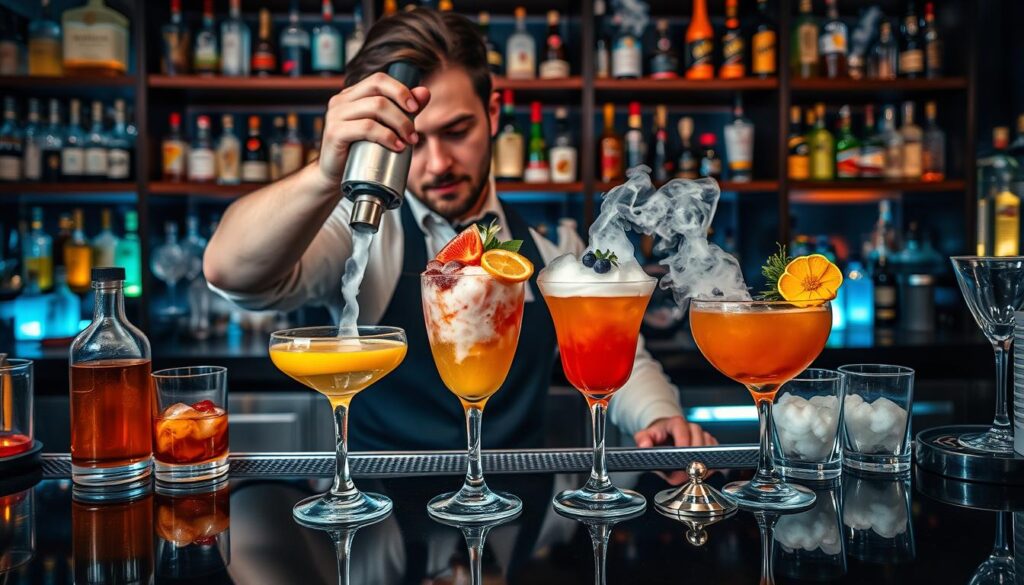
Mixology has undergone remarkable changes, reshaping cocktail trends. The 19th century marked a turning point in mixology techniques. Four key developments emerged: artificial carbonation, ice for sale, refrigeration, and continuous distillation.
Ice availability transformed modern cocktails. It chilled drinks and blended flavours seamlessly. Bitters added complexity to cold drinks, elevating cocktail creation.
| Innovation | Year | Impact on Mixology |
|---|---|---|
| Artificial Carbonation | 1767 | Enabled creation of fizzy cocktails |
| Ice for Sale in America | 1800 | Revolutionised drink chilling and dilution |
| Refrigeration | 1803 | Improved ingredient preservation |
| Continuous Distillation | 1826 | Enhanced spirit quality and consistency |
Mixology keeps evolving. The Ready-to-Drink category is booming, with craft cocktails in high demand. Bartenders use molecular mixology to create precise drinks.
Algorithms now analyse preferences to suggest tailored cocktails. This mix of old and new keeps mixology exciting and fresh.
The Gold Rush Era: Cocktails Go West
The 1849 Gold Rush sparked a cocktail revolution in California. Miners craved liquid courage and energy. This new drinking culture shaped the future of mixology.
Breakfast Gin Cocktails: A Miner’s Morning Ritual
Gold Rush miners had a unique morning ritual. They started their day with a ‘Gin Cocktail’. This potent mix of gin, sugar, and bitters gave them a quick energy boost.
These cocktails were often consumed before dawn. The mix of sugar and alcohol offered a brief escape from tough mining life.
The Sazerac: New Orleans’ Signature Drink
While California miners sipped gin, New Orleans crafted its own cocktail legacy. The Sazerac, born in the 1830s, became the city’s signature drink.
Antoine Peychaud created special bitters for the Sazerac. The drink was first made with cognac, then with rye whiskey. It truly captures New Orleans’ spirit.
| Cocktail | Origin | Key Ingredients | Cultural Significance |
|---|---|---|---|
| Gin Cocktail | California Gold Rush | Gin, sugar, bitters | Miners’ breakfast drink |
| Sazerac | New Orleans | Rye whiskey, Peychaud’s bitters, sugar | City’s official cocktail |
The Gold Rush era changed cocktail history forever. Drinks like the Gin Cocktail and Sazerac led to new mixology innovations.
Cocktails: A Global Phenomenon
Cocktail culture spread across the globe in the 19th century. International cocktails became a symbol of sophistication in global mixology. Each country added its unique twist to the growing cocktail scene.
England’s James Pimm created Pimm’s No. 1 Cup, capturing British summer’s essence. The Royal Navy introduced pink gin, blending Plymouth gin with Angostura bitters. France began experimenting with liqueur combinations in the 1850s.
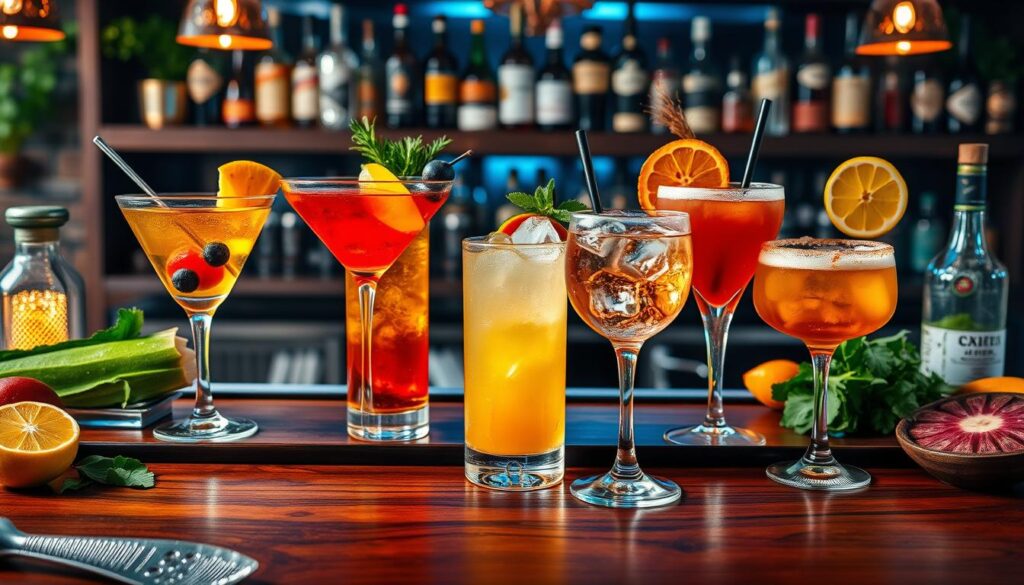
The Collins cocktail sparked international debate about its origins. It’s a mix of gin, lemon juice, sugar, and carbonated water. This debate highlighted the interconnected nature of global mixology.
| Country | Signature Cocktail | Key Ingredient |
|---|---|---|
| England | Pimm’s Cup | Pimm’s No. 1 |
| France | Kir Royale | Crème de Cassis |
| Italy | Negroni | Campari |
| Cuba | Mojito | White Rum |
Bartenders worldwide began crafting their own signature drinks. They often used local ingredients and flavours. This led to an endless array of unique cocktail variations.
The Prohibition Era: Speakeasies and Hidden Flavours
The Prohibition Era lasted from 1920 to 1933. It sparked a revolution in cocktail culture. Speakeasies, underground drinking dens, became hotbeds for mixology creativity.
Underground Drinking Dens: The Rise of Speakeasies
Speakeasies were secret venues serving illicit drinks during Prohibition. These hidden bars became social hubs. They fostered a new breed of cocktails.
The Old Fashioned, Sidecar, and Gin Rickey were born in these clandestine spots. These drinks marked a significant chapter in cocktail history.
Masking Poor Quality Spirits: Bold Flavours Take Centre Stage
Prohibition cocktails were made to hide the taste of bad alcohol. Bartenders used strong flavours like citrus, bitters, and herbs. This led to bold drinks like the Bee’s Knees and French 75.
The Gin Revolution: Home Distilling Takes Off
The era saw a boom in homemade spirits, especially gin. It was easy to make, so amateur distillers loved it. Speakeasy drinks often used gin as the base spirit.
This led to a surge in gin-based cocktails. These drinks continue to influence modern mixology today.
The legacy of Prohibition-era speakeasies lives on. Many modern bars draw inspiration from this period. They recreate classics with contemporary twists using house-made syrups and local ingredients.
The creativity born from necessity during Prohibition still shapes cocktails today. It continues to influence the exciting world of mixology we enjoy.
Post-Prohibition: The Cocktail Renaissance
The repeal of Prohibition in 1933 sparked a new era for cocktails. Public interest in mixed drinks soared. Writers like Ernest Hemingway helped popularise classics such as the Daiquiri and Negroni.
Cocktails boomed in the 1960s and 70s. James Bond’s famous Martini fueled this trend. This era kicked off a cocktail renaissance that’s still evolving today.
Craft cocktails are now centre stage in modern mixology. Bartenders are seen as artisans, creating unique flavour combos. This has sparked interest in classic recipes and new innovative drinks.
“The art of mixology is a perfect blend of science and creativity, turning ordinary ingredients into extraordinary experiences.”
Specialised bars, mixology schools, and competitions are on the rise. These platforms boost innovation in cocktail making. The industry is booming with creativity as bartenders push traditional limits.
- Increase in craft cocktail bars
- Rise of mixology as a respected profession
- Growing interest in artisanal spirits and ingredients
- Revival of forgotten classic recipes
The cocktail renaissance has become a global phenomenon. Each culture adds its unique twist to mixology. This rich blend of flavours and techniques keeps drink lovers hooked worldwide.
Cocktails in Popular Culture: From Literature to Cinema
Cocktails have become stars in pop culture. They’ve left their mark on books and movies. These drinks are now characters in their own right.
Authors love to write about cocktails. Ernest Hemingway often included drinks in his stories. His characters enjoyed whiskey sours, a classic from Jerry Thomas’s 1862 book.
The gimlet gained fame through Raymond Chandler’s 1953 novel “The Long Goodbye”. Chandler’s character described it as “half gin and half Rose’s Lime Juice”.
“A real gimlet is half gin and half Rose’s Lime Juice and nothing else.” – Raymond Chandler, The Long Goodbye
In movies, cocktails often reflect character personalities. James Bond’s “shaken, not stirred” martini in “Goldfinger” (1964) is a famous example. It cemented the cocktail’s place in film history.
On-screen drinks influence real-world trends. The Cosmopolitan became popular thanks to “Sex and the City”. “The Big Lebowski” brought new life to the White Russian.
These fictional favourites inspire real-world drinking. They show the lasting power of cocktails in our cultural imagination.
The Role of Scotch Whisky in Cocktail History
Scotch whisky has shaped cocktail culture for nearly 200 years. Its rich flavour and versatility make it a favourite among mixologists and drinkers. Scotch’s unique qualities have cemented its place in the world of mixed drinks.
Whisky’s Enduring Popularity in Classic Cocktails
Scotch whisky cocktails have stood the test of time. Classic drinks like the Old Fashioned remain popular today. The Rob Roy, a Manhattan-style cocktail made with Scotch, is another enduring favourite.
The Prestige of Authentic Scotch During Prohibition
During Prohibition, authentic Scotch whisky gained prestige. While other spirits were often diluted, Scotch maintained its quality. This led to increased demand and respect for the spirit.
Whisky Cocktails: From Old Fashioned to Modern Creations
Modern whisky mixology has expanded the Scotch cocktail repertoire. Bartenders are creating innovative drinks that showcase Scotch’s complex flavours. Some mix it with unexpected ingredients like fruit juices or herbal liqueurs.
| Classic Whisky Drinks | Modern Whisky Mixology |
|---|---|
| Old Fashioned | Penicillin |
| Rob Roy | Blood and Sand |
| Rusty Nail | Smoky Cokey |
Scotch whisky’s role in cocktail history is significant. It makes up 70% of Scotland’s food and drink exports, showing its global appeal. Over 130 active distilleries in Scotland produce a vast variety of Scotch for cocktails.
This diversity allows for endless creativity in modern whisky mixology. Bartenders can experiment with different flavour profiles to create unique and exciting drinks.
Conclusion
Cocktails have evolved from ancient mixtures to today’s signature drinks. This journey reflects cultural changes and technological progress. Modern mixologists draw inspiration from two centuries of recipes to create new and classic drinks.
A typical 350 ml cocktail with 40% ABV contains 140 ml of alcohol. Mixers and ice dilution can lower the drink’s strength. Some visually appealing cocktails may hide their high alcohol content.
The cocktail scene now features simple, elegant drinks and complex concoctions. Homemade syrups and unique flavour combinations are becoming popular. Mocktails are also gaining traction, offering tasty non-alcoholic options.
Mixology’s future is exciting, with endless possibilities for new signature drinks. The world of mixed drinks caters to all tastes. This ensures the ongoing growth of cocktail culture.

